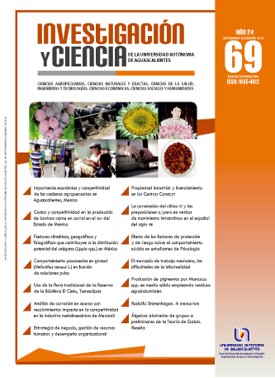Pigments production by Monascus spp. in solid medium using agroindustrial waste
DOI:
https://doi.org/10.33064/iycuaa2016691875Keywords:
natural dyes, filamentous fungus, solid-state fermentation, sustainable technologiesAbstract
In this review the main factors affecting pigment production by Monascus in solid medium are described, as well as the different agro-industrial waste used and those potential regional wastes in Mexico that can be exploited in the production of pigments. The pigments produced by the fungus Monascus have shown potential application in food, textile, cosmetics and pharmaceutical industries. Pigment production by Monascus has been carried out mainly in solid-state fermentation, for which the use of agro-industrial waste as a source of substrate is a real alternative that increases the economic feasibility of the process with low-impact environmental. The factors of temperature, pH, humidity and particle size were identified as the most influential factors in pigment production and the regional agro-industrial waste of corn, rice and Aloe vera the substrates with higher yield.
Downloads
References
• BABITHA, S. et al. Jackfruit seed-A novel substrate for the production of Monascus pigments through solid-state fermentation. Food Technology and Biotechnology, 44, 465-471, 2006.
• BABITHA, S. et al. Solid-state fermentation for the production of Monascus pigments from jackfruit seed. Bioresource Technology, 98(8): 1554-1560, 2007.
• BECHTOLD, T. et al. Extraction of natural dyes for textile dyeing from coloured plant wastes released from the food and beverage industry. Journal of the Science of Food and Agriculture, 86(2): 233-242, 2006.
• BENAVENTE VALDÉS, J. R. et al. Strategies to enhance the production of photosynthetic pigments and lipids in chlorophycae species. Biotechnology Reports, 10, 117-125, 2016.
• BOTELLA, C. et al. Xylanase and pectinase production by Aspergillus awamori on grape pomace in solid state fermentation. Process Biochemistry, 42(1): 98-101, 2007.
• CARVALHO, J. C. et al. Production of Monascus biopigments: an overview. Agro FOOD industry hi-tech, 14(6): 37-42, 2003.
• CARVALHO, J. C. et al. Relation between growth, respirometric analysis and biopigments production from Monascus by solidstate fermentation. Biochemical Engineering Journal, 29(3):262-269, 2006.
• CELESTINO, J. D. R. et al. Bioprospecting of Amazon soil fungi with the potential for pigment production. Process Biochemistry, 49(4): 569-575, 2014.
• CHENG, M. J. et al. Secondary metabolites produced by the fungus Monascus pilosus and their anti-inflammatory activity. Phytochemistry Letters, 5(3): 567-571, 2012.
• DÍAZ SÁNCHEZ, A. B. Reciclado del orujo de uva como medio sólido de fermentación para la producción de enzimas hidrolíticas de interés industrial. Tesis doctoral. España: Universidad de Cádiz, 2009.
• DUFOSSÉ, L. et al. Microorganisms and microalgae as sources of
pigments for food use: a scientific oddity or an industrial reality?. Trends in Food Science & Technology, 16(9): 389-406, 2005.
• DURSUN, D. y DALGIÇ, A. C. Optimization of astaxanthin pigment bioprocessing by four different yeast species using wheat wastes. Biocatalysis and Agricultural Biotechnology, 7, 1-6, 2016.
• GENERAL, T. et al. Fungal utilization of a known and safe macroalga for pigment production using solid-state fermentation. Journal of Applied Phycology, 26(3): 1547-1555, 2014.
• HAN, O. y MUDGETT, R. E. Effects of oxygen and carbon dioxide partial pressures on Monascus growth and pigment production in solid‐state fermentation. Biotechnology Progress, 8, 5-10, 1992.
• HSU, W. H. y PAN, T. M. Monascus purpureus-fermented products and oral cancer: a review. Applied Microbiology and Biotechnology, 93(5): 1831-1842, 2012.
• JOHNS, M. R. y STUART, D. M. Production of pigments by Monascus purpureus in solid culture. Journal of Industrial Microbiology, 8(1): 23-28, 1991.
• KASINSKI, S. y WOJNOWSKA BARYLA, I. Oxygen demand for the stabilization of the organic fraction of municipal solid waste in passively aerated bioreactors. Waste management, 34(2): 316-322, 2014.
• LI, C. H. et al. Safety and mutagenecity evaluation of red mold dioscorea fermented from Monascus purpureus NTU 568. Food and Chemical Toxicology. 67, 161-168, 2014.
• LIAN, X. et al. Identification of new red pigments produced by Monascus ruber. Dyes and Pigments, 73(1): 121-125, 2007.
• LOTONG, N. y SUWANARIT, P. Fermentation of ang-kak in plastic bags and regulation of pigmentation by initial moisture content. Journal of Applied Microbiology, 68(6): 565-570, 1990.
• MORALES OYERVIDES, L. et al. Effect of heat exposure on the colour intensity of red pigments produced by Penicillium purpurogenum GH2. Journal of Food Engineering, 164, 21-29, 2015.
• NAM, K. et al. Antiobesity effect of a jelly food containing the L-tryptophan derivative of Monascus pigment in mice. Journal of Functional Foods, 9, 306-314, 2014.
• PANDEY, A. Solid-state fermentation. Biochemical Engineering Journal, 13(2-3): 81-84, 2003.
• PANDEY, A. et al. New developments in solid-state fermentation: I-bioprocesses and products. Process Biochemistry, 35(10): 1153-1169, 2000.
• PANDEY, S. et al. Coping with drought in rice farming in Asia: insights from a cross-country comparative study. Agricultural Economics, 37(s1): 213-224, 2007.
• PANESAR, R. et al. Production of microbial pigments utilizing agro-industrial waste: a re
Downloads
Published
How to Cite
Issue
Section
Categories
License
Las obras publicadas en versión electrónica de la revista están bajo la licencia Creative Commons Atribución-NoComercial-CompartirIgual 4.0 Internacional (CC BY-NC-SA 4.0)









